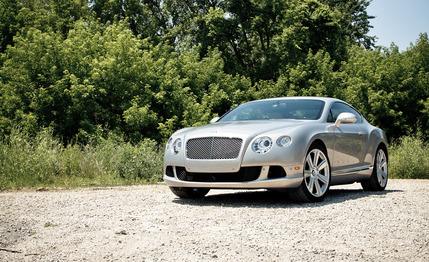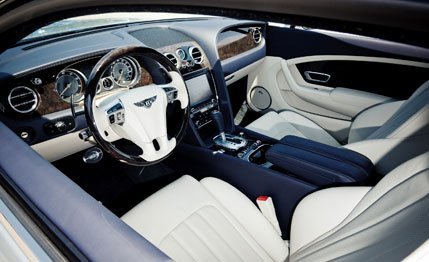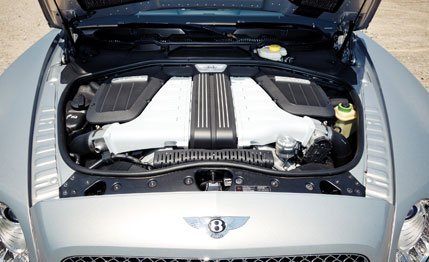 Instrumented Test
Instrumented Test

You’ve just inked your first big-time pro-sports contract, scored your third top-10 single, or finally cracked the seal on that trust fund. You might think you’ve arrived on Easy Street, but now the real work begins: Dom or Cristal, Rolex or Breitling, Roller or Bentley?
A few years ago, the latter choice might easily have involved Mercedes-Benz, Range Rover, or BMW—Ferraris, Lambos, and similar exotics are second cars, of course—but Bentley is deep in the throes of its renaissance. In the first six months of 2012 alone, the VW-owned boutique brand peddled 3929 vehicles worldwide. Not bad for a marque that nearly slipped into obscurity in the late 20th century, surviving largely on rebadged models co-opted from then parent company Rolls-Royce.
With Bentley securely reinserted into the lexicon of popular culture, we grabbed some seat time in a Continental GT W-12, the twin-turbo, 12-cylinder version of the brand’s bestselling model. (A V-8–powered Conti GT was recently introduced as a more efficient starter kit for the brand.)
What, Me Worry?
From the driver’s seat, all concerns regarding girth and efficiency dissipate like air flowing through the Continental GT’s fully ventilated leather seats. Although the Bentley is no Miata, its heft and size diminish significantly with each minute behind the wheel. The optional three-spoke, wood-and-hide-covered steering wheel ($1150) has a sturdy, reassuring quality that defies its elegance. The weight of the speed-sensitive, ZF-supplied power steering is consistent before loading up a bit more at full lock, and the nose goes where you ask right away, although the rest of the car takes a beat to receive the message, and the setup isn’t particularly insightful regarding road textures.

Take the GT in this car’s name to heart. It doesn’t like to be hustled, preferring instead to briskly gobble up miles. A ponderous 37.1-foot turning radius provides one clue to its true nature, and when the Conti is pushed to its limits, it prefers gentle understeer to tail-out antics, despite the permanent 40/60 torque split of the standard all-wheel-drive system. Our car was outfitted with the $3110 21-inch painted aluminum wheels with Pirelli P Zero tires (chrome rollers command $5340); despite their size, highway cruising was quiet, and straight-ahead tracking was true. Bentley’s continuous damping control adjusts the suspension’s firmness hundreds of times a second, working overtime to minimize body roll while keeping harsh impacts at bay. Even so, severe impacts resonate gently throughout the vehicle with the deep tonality of distant and well-damped timpani; accurately time a trip down an expansion-joint-littered freeway, and you might be able to re-create the iconic percussion intro from Richard Strauss’s Also Sprach Zarathustra (a.k.a. the theme from 2001: A Space Odyssey).
Pistons by the Dozen
With a 567-hp, 6.0-liter twin-turbo 12-cylinder (Bentley’s version of the VW Group’s familial W-12) under the hood, the Continental GT turned in a 4.4-second dash to 60 and a 12.8-second quarter-mile. Our tester noted that it took a cool engine and “major” brake-torquing to extract the quickest acceleration. From outside the vehicle, the exhaust note is pure Chris-Craft, albeit slightly more refined and muted by several decibels; from the cockpit, the underhood ruckus is just brash enough to encourage flat-footing it—witness our 14-mpg combined fuel economy.

Column-mounted paddles allow lively drivers to shift the ZF-supplied six-speed automatic transmission manually, and although the gearswaps happen quickly enough, we found no real reason to shift for ourselves beyond the healthful benefits of finger calisthenics. Although the Conti GT is capable of simulating manual-trans-style rev-matched downshifts and allows for double downshifts (e.g., fourth to second gear), its country-club-like interior encourages one to sit back and let the hired help handle laborious chores such as changing ratios.
The brakes work hard to earn their keep, the 15.9-inch vented front rotors and 13.2-inchers in the rear providing braking performance that defies the GT’s plump physique. Braking from 70 mph to 0 took 162 feet, three fewer feet than we recently recorded with a lithe and limber Subaru BRZ coupe. Of course, the BRZ retails for nearly—ahem— $195,000 less than this Continental GT, which equates to $65,000 a foot. Feel and feedback are different stories altogether, the GT’s pedal evoking a distant, vaguely hydraulic sensation in contrast to the BRZ’s nearly telepathic pedal response. (And that concludes the Apples-to-Fish Comparison Hour here at C/D. Don’t forget to tip your waitress!)